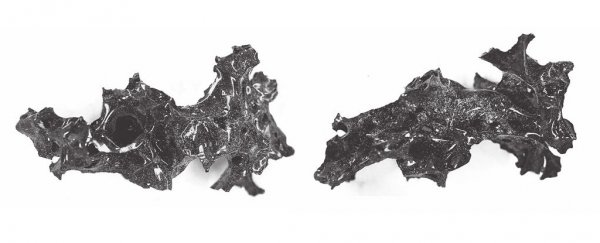The devastating volcanic eruption of Mount Vesuvius in 79 CE – which wiped out settlements including Pompeii and Herculaneum in blasts of molten rock and ash – may have turned the brains of some of its sorry victims to glass, a new study concludes.
Analysis of one skull, recovered from the Herculaneum site in the 1960s, shows brain matter that has been vitrified, or turned into glass. While some human brains at the site were found to have been saponified – turned into a soap-like substance – this is the first time that the glass idea has been put forward.
The fatty acids and proteins found in the substance, and the localised nature of the material, suggest this is a brain exposed to sudden, intense heat, according to the researchers.
Temperatures at the site could have been as high as 520 degrees Celsius (968 degrees Fahrenheit), based on an analysis of nearby charred wood.
 Fragment of glassy material. (Petrone et al., NEJM, 2020)
Fragment of glassy material. (Petrone et al., NEJM, 2020)
"The detection of a glassy material from the victim's head, of proteins expressed in [the] human brain, and of fatty acids found in human hair indicates the thermally induced preservation of vitrified human brain tissue," write the researchers.
The unfortunate person – estimated to be a 25-year-old male – was found lying on a wooden bed, buried in volcanic ash, and is thought to have been a caretaker for the Collegium Augustalium building he was found in.
The team behind the new analysis suggests extreme radiant heat would have ignited the poor man's body fat and vapourised his soft tissues.
 Glassy black material filling the skull. (Petrone et al., NEJM, 2020)
Glassy black material filling the skull. (Petrone et al., NEJM, 2020)
A period of cooling would then have followed, mimicking the way that glass is made. To be moulded into shapes, glass needs to be heated to 1400 degrees Celsius (2552 degrees Fahrenheit), but it can be formed at lower temperatures.
"The preservation of ancient brain remains is an extremely rare find," forensic anthropologist Pier Paolo Petrone, from the University of Naples Federico II in Italy, told Sara G. Miller at NBC News.
"This is the first-ever discovery of ancient human brain remains, vitrified by heat."
It's tricky to know exactly what happened, but there's no doubt this would have felt like a truly apocalyptic moment, as high-speed pyroclastic surges of gas and rock were rapidly followed by waves of volcanic ash. If you lived in Pompeii or Herculaneum, you wouldn't have really stood a chance.
The research fits in with previous work from Petrone and others, finding that body fluids and soft tissues of victims on the shore of Herculaneum were suddenly vaporised. The man with the glass brain was discovered further back from the water.
Peering back so far in time, and at such an unusual event, requires a lot of educated guesswork, and so it must be noted that not everyone agrees with the brain-into-glass theory.
Forensic anthropologist Tim Thompson, from Teesside University in the UK, thinks the victims at Herculaneum may have been "baked" through exposure to low-intensity heat.
"We need to do more research in this area to see if we can reproduce the conditions in which [the glassy material] formed to truly interpret its significance," Thompson told Kristina Killgrove at Forbes.
The research has been published in the New England Journal of Medicine.
